2007 CHEVROLET SILVERADO torque
[x] Cancel search: torquePage 141 of 684
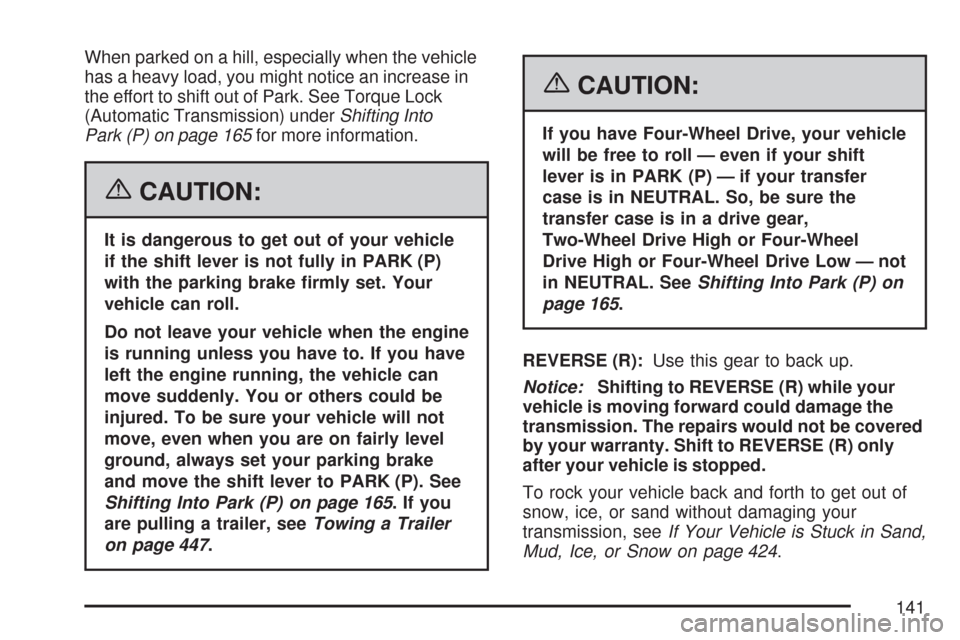
When parked on a hill, especially when the vehicle
has a heavy load, you might notice an increase in
the effort to shift out of Park. See Torque Lock
(Automatic Transmission) underShifting Into
Park (P) on page 165for more information.
{CAUTION:
It is dangerous to get out of your vehicle
if the shift lever is not fully in PARK (P)
with the parking brake �rmly set. Your
vehicle can roll.
Do not leave your vehicle when the engine
is running unless you have to. If you have
left the engine running, the vehicle can
move suddenly. You or others could be
injured. To be sure your vehicle will not
move, even when you are on fairly level
ground, always set your parking brake
and move the shift lever to PARK (P). See
Shifting Into Park (P) on page 165.Ifyou
are pulling a trailer, seeTowing a Trailer
on page 447.
{CAUTION:
If you have Four-Wheel Drive, your vehicle
will be free to roll — even if your shift
lever is in PARK (P) — if your transfer
case is in NEUTRAL. So, be sure the
transfer case is in a drive gear,
Two-Wheel Drive High or Four-Wheel
Drive High or Four-Wheel Drive Low — not
in NEUTRAL. SeeShifting Into Park (P) on
page 165.
REVERSE (R):Use this gear to back up.
Notice:Shifting to REVERSE (R) while your
vehicle is moving forward could damage the
transmission. The repairs would not be covered
by your warranty. Shift to REVERSE (R) only
after your vehicle is stopped.
To rock your vehicle back and forth to get out of
snow, ice, or sand without damaging your
transmission, seeIf Your Vehicle is Stuck in Sand,
Mud, Ice, or Snow on page 424.
141
Page 146 of 684
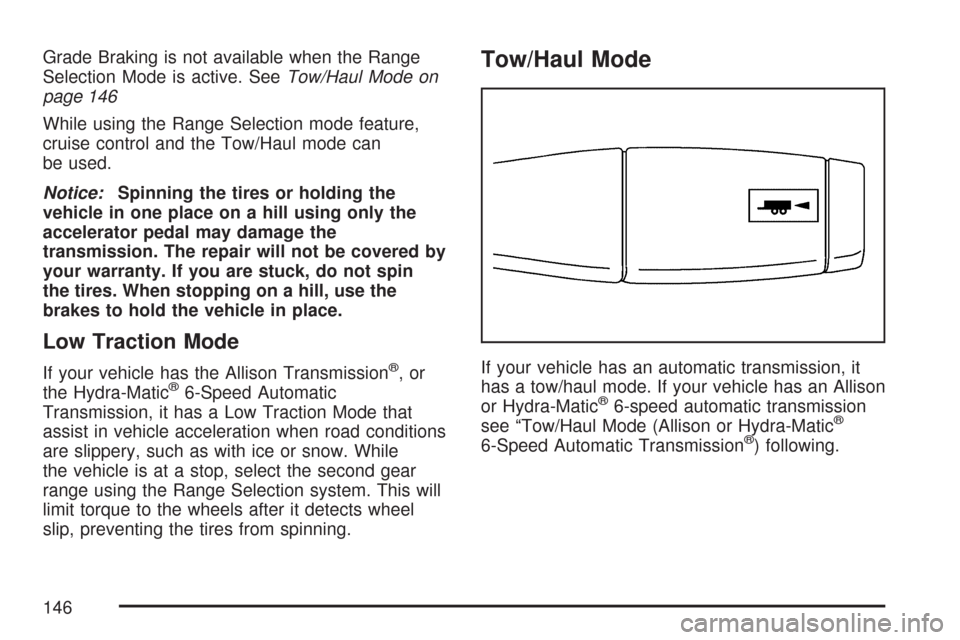
Grade Braking is not available when the Range
Selection Mode is active. SeeTow/Haul Mode on
page 146
While using the Range Selection mode feature,
cruise control and the Tow/Haul mode can
be used.
Notice:Spinning the tires or holding the
vehicle in one place on a hill using only the
accelerator pedal may damage the
transmission. The repair will not be covered by
your warranty. If you are stuck, do not spin
the tires. When stopping on a hill, use the
brakes to hold the vehicle in place.
Low Traction Mode
If your vehicle has the Allison Transmission®,or
the Hydra-Matic®6-Speed Automatic
Transmission, it has a Low Traction Mode that
assist in vehicle acceleration when road conditions
are slippery, such as with ice or snow. While
the vehicle is at a stop, select the second gear
range using the Range Selection system. This will
limit torque to the wheels after it detects wheel
slip, preventing the tires from spinning.
Tow/Haul Mode
If your vehicle has an automatic transmission, it
has a tow/haul mode. If your vehicle has an Allison
or Hydra-Matic
®6-speed automatic transmission
see “Tow/Haul Mode (Allison or Hydra-Matic®
6-Speed Automatic Transmission®) following.
146
Page 148 of 684
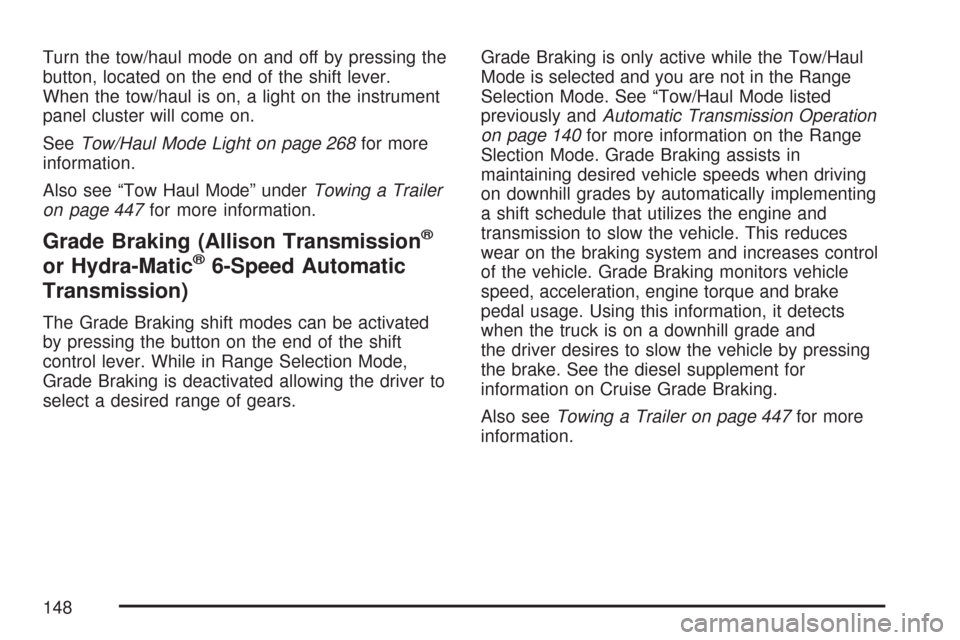
Turn the tow/haul mode on and off by pressing the
button, located on the end of the shift lever.
When the tow/haul is on, a light on the instrument
panel cluster will come on.
SeeTow/Haul Mode Light on page 268for more
information.
Also see “Tow Haul Mode” underTowing a Trailer
on page 447for more information.
Grade Braking (Allison Transmission®
or Hydra-Matic®6-Speed Automatic
Transmission)
The Grade Braking shift modes can be activated
by pressing the button on the end of the shift
control lever. While in Range Selection Mode,
Grade Braking is deactivated allowing the driver to
select a desired range of gears.Grade Braking is only active while the Tow/Haul
Mode is selected and you are not in the Range
Selection Mode. See “Tow/Haul Mode listed
previously andAutomatic Transmission Operation
on page 140for more information on the Range
Slection Mode. Grade Braking assists in
maintaining desired vehicle speeds when driving
on downhill grades by automatically implementing
a shift schedule that utilizes the engine and
transmission to slow the vehicle. This reduces
wear on the braking system and increases control
of the vehicle. Grade Braking monitors vehicle
speed, acceleration, engine torque and brake
pedal usage. Using this information, it detects
when the truck is on a downhill grade and
the driver desires to slow the vehicle by pressing
the brake. See the diesel supplement for
information on Cruise Grade Braking.
Also seeTowing a Trailer on page 447for more
information.
148
Page 150 of 684
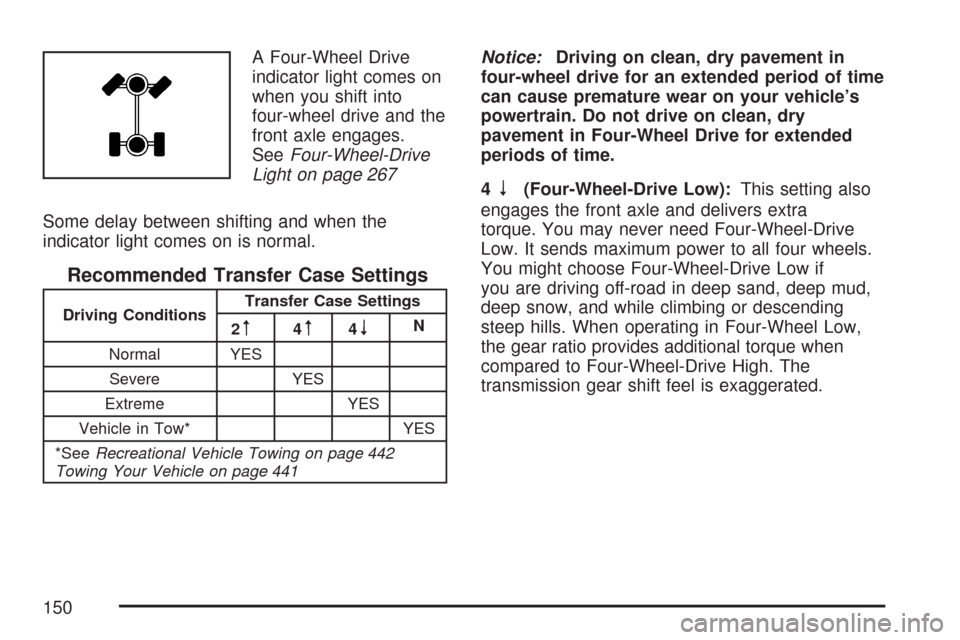
A Four-Wheel Drive
indicator light comes on
when you shift into
four-wheel drive and the
front axle engages.
SeeFour-Wheel-Drive
Light on page 267
Some delay between shifting and when the
indicator light comes on is normal.
Recommended Transfer Case Settings
Driving ConditionsTransfer Case Settings
2m4m4nN
Normal YES
Severe YES
Extreme YES
Vehicle in Tow* YES
*SeeRecreational Vehicle Towing on page 442
Towing Your Vehicle on page 441
Notice:Driving on clean, dry pavement in
four-wheel drive for an extended period of time
can cause premature wear on your vehicle’s
powertrain. Do not drive on clean, dry
pavement in Four-Wheel Drive for extended
periods of time.
4
n(Four-Wheel-Drive Low):This setting also
engages the front axle and delivers extra
torque. You may never need Four-Wheel-Drive
Low. It sends maximum power to all four wheels.
You might choose Four-Wheel-Drive Low if
you are driving off-road in deep sand, deep mud,
deep snow, and while climbing or descending
steep hills. When operating in Four-Wheel Low,
the gear ratio provides additional torque when
compared to Four-Wheel-Drive High. The
transmission gear shift feel is exaggerated.
150
Page 155 of 684
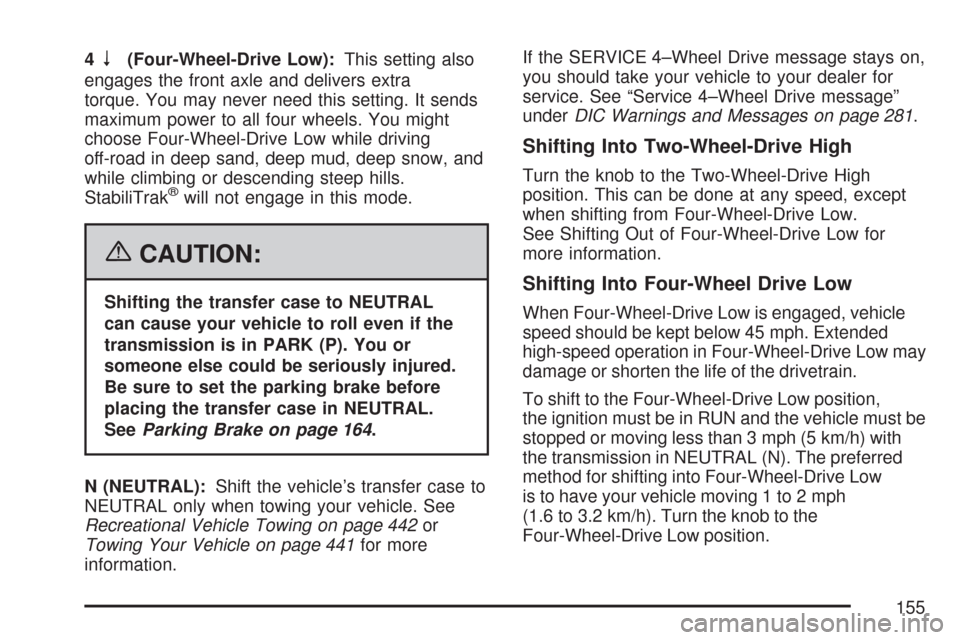
4n(Four-Wheel-Drive Low):This setting also
engages the front axle and delivers extra
torque. You may never need this setting. It sends
maximum power to all four wheels. You might
choose Four-Wheel-Drive Low while driving
off-road in deep sand, deep mud, deep snow, and
while climbing or descending steep hills.
StabiliTrak
®will not engage in this mode.
{CAUTION:
Shifting the transfer case to NEUTRAL
can cause your vehicle to roll even if the
transmission is in PARK (P). You or
someone else could be seriously injured.
Be sure to set the parking brake before
placing the transfer case in NEUTRAL.
SeeParking Brake on page 164.
N (NEUTRAL):Shift the vehicle’s transfer case to
NEUTRAL only when towing your vehicle. See
Recreational Vehicle Towing on page 442or
Towing Your Vehicle on page 441for more
information.If the SERVICE 4–Wheel Drive message stays on,
you should take your vehicle to your dealer for
service. See “Service 4–Wheel Drive message”
underDIC Warnings and Messages on page 281.
Shifting Into Two-Wheel-Drive High
Turn the knob to the Two-Wheel-Drive High
position. This can be done at any speed, except
when shifting from Four-Wheel-Drive Low.
See Shifting Out of Four-Wheel-Drive Low for
more information.
Shifting Into Four-Wheel Drive Low
When Four-Wheel-Drive Low is engaged, vehicle
speed should be kept below 45 mph. Extended
high-speed operation in Four-Wheel-Drive Low may
damage or shorten the life of the drivetrain.
To shift to the Four-Wheel-Drive Low position,
the ignition must be in RUN and the vehicle must be
stopped or moving less than 3 mph (5 km/h) with
the transmission in NEUTRAL (N). The preferred
method for shifting into Four-Wheel-Drive Low
is to have your vehicle moving 1 to 2 mph
(1.6 to 3.2 km/h). Turn the knob to the
Four-Wheel-Drive Low position.
155
Page 160 of 684
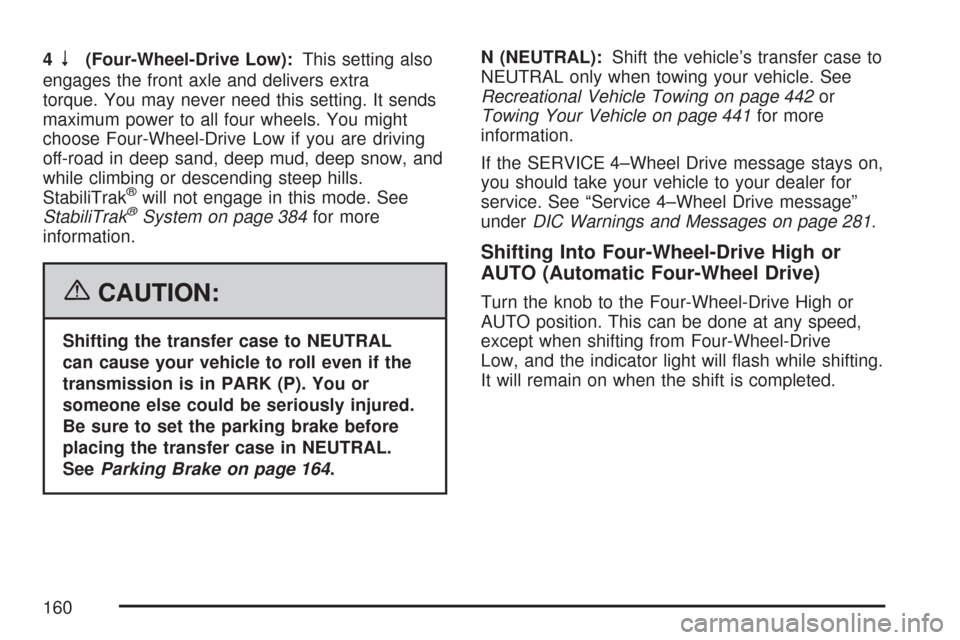
4n(Four-Wheel-Drive Low):This setting also
engages the front axle and delivers extra
torque. You may never need this setting. It sends
maximum power to all four wheels. You might
choose Four-Wheel-Drive Low if you are driving
off-road in deep sand, deep mud, deep snow, and
while climbing or descending steep hills.
StabiliTrak
®will not engage in this mode. See
StabiliTrak®System on page 384for more
information.
{CAUTION:
Shifting the transfer case to NEUTRAL
can cause your vehicle to roll even if the
transmission is in PARK (P). You or
someone else could be seriously injured.
Be sure to set the parking brake before
placing the transfer case in NEUTRAL.
SeeParking Brake on page 164.N (NEUTRAL):Shift the vehicle’s transfer case to
NEUTRAL only when towing your vehicle. See
Recreational Vehicle Towing on page 442or
Towing Your Vehicle on page 441for more
information.
If the SERVICE 4–Wheel Drive message stays on,
you should take your vehicle to your dealer for
service. See “Service 4–Wheel Drive message”
underDIC Warnings and Messages on page 281.
Shifting Into Four-Wheel-Drive High or
AUTO (Automatic Four-Wheel Drive)
Turn the knob to the Four-Wheel-Drive High or
AUTO position. This can be done at any speed,
except when shifting from Four-Wheel-Drive
Low, and the indicator light will �ash while shifting.
It will remain on when the shift is completed.
160
Page 167 of 684
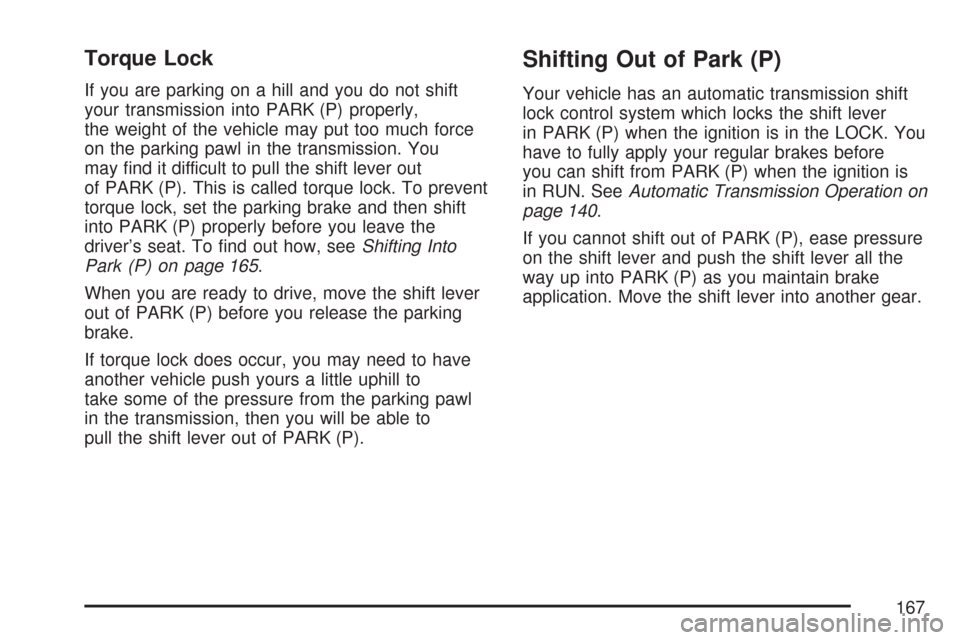
Torque Lock
If you are parking on a hill and you do not shift
your transmission into PARK (P) properly,
the weight of the vehicle may put too much force
on the parking pawl in the transmission. You
may �nd it difficult to pull the shift lever out
of PARK (P). This is called torque lock. To prevent
torque lock, set the parking brake and then shift
into PARK (P) properly before you leave the
driver’s seat. To �nd out how, seeShifting Into
Park (P) on page 165.
When you are ready to drive, move the shift lever
out of PARK (P) before you release the parking
brake.
If torque lock does occur, you may need to have
another vehicle push yours a little uphill to
take some of the pressure from the parking pawl
in the transmission, then you will be able to
pull the shift lever out of PARK (P).
Shifting Out of Park (P)
Your vehicle has an automatic transmission shift
lock control system which locks the shift lever
in PARK (P) when the ignition is in the LOCK. You
have to fully apply your regular brakes before
you can shift from PARK (P) when the ignition is
in RUN. SeeAutomatic Transmission Operation on
page 140.
If you cannot shift out of PARK (P), ease pressure
on the shift lever and push the shift lever all the
way up into PARK (P) as you maintain brake
application. Move the shift lever into another gear.
167
Page 202 of 684

To remove or install cargo tie-downs at the front of
the bed, slide the corner cap towards the center of
the bed to expose the rail notches. To remove the
corner cap, pull either edge away from the rail.
To remove the system, loosen the toggle bolts on
each rail until they can be removed from the bed of
the truck. To replace the system, place the toggle
bolts and rails into their original locations and
tighten them to a torque setting of
12.5 ft-lbs (17
Y).
If the system is removed to install a bed liner, make
sure there is no bed liner material in the installation
points.
Notice:If you tie down cargo using the
horizontal slots on the top of the pickup box,
you may damage the box. Using the horizontal
slots on the top of the pickup box for tie-down
locations may cause damage to the pickup box
and would not be covered by your warranty.
Only use the tie-down loops if you do not have
the cargo management system.
Sunroof
If your vehicle has a power sliding sunroof, the
ignition needs to be turned to RUN, or the
Retained Accessory Power (RAP) must be
activated to open or close the sunroof. When RAP
is active, the sunroof will work for 10 minutes
after the ignition is turned off, or until the driver’s
door is opened. SeeRetained Accessory
Power (RAP) on page 136for more information.
Extended Cab
If your vehicle is an
extended-cab, the
sunroof switch is located
on the headliner above
the rearview mirror.
Vent:From the closed position, press and hold the
rear of the switch to vent the sunroof. To close the
sunroof, press and hold the front of the switch.
202